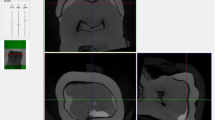Abstract
Objectives
Recently, it has become possible to reconstruct complete occlusal surfaces using the biogeneric tooth model. This study aimed to mathematically assess and compare the morphologic agreement between original morphology and CAD-reconstructed, waxed-up and CAM partial crowns.
Materials and methods
Thirty-nine intact first permanent molars (39 participants) were included. Impressions, bite registrations and three gypsum replicas were made. Preparations for CAD/CAM partial crowns were performed and scanned. The restorations were biogenerically reconstructed (CEREC® v3.80) and milled. Wax-ups of these preparations were scanned as well as the milled restorations and original teeth. Discrepancies were evaluated by matching the scans with the original morphologies (Match3D, output: volume/area, z difference) and by contact patterns. The discrepancies were compared between CAD-reconstructions and either wax-ups or milled restorations (paired t test, α = 0.025 for two multiple tests).
Results
The mean differences between natural tooth morphology (triangular stabilisation 71.8 %) and biogeneric reconstructions, wax-ups and milled restorations (triangular stabilisation 87.2 %) were: 184 ± 36 μm (volume/area), 187 ± 41 μm (z difference); 263 ± 40 μm (volume/area), 269 ± 45 μm (z difference) and 182 ± 40 μm (volume/area), 184 ± 41 μm (z difference). Differences associated with biogeneric reconstructions were significantly less than those of wax-ups (volume/area and z difference, p < 0.0001), but not significantly different than those of milled restorations (p = 0.423 (volume/area), p = 0.110 (z difference)).
Conclusions
CAD software enables a closer reconstruction of teeth than do wax-ups, even when no cusps remain. The milling device is precise enough to transfer CAD into the final restoration.
Clinical relevance
This study shows that state of the art CAD/CAM can effectively produce natural tooth morphology and may be ideal for fixed partial dentures.




Similar content being viewed by others
References
Türp JC, Greene CS, Strub JE (2008) Dental occlusion: a critical reflection on past, present and future concepts. J Oral Rehabil 35:446–453
Mattiola A, Mörmann WH, Lutz F (1995) The computer-generated occlusion of CEREC-2 inlays and onlays. Schweiz Monatsschr Zahnmed 105:1284–1290
De Nisco S, Mörmann WH (1996) Computer-generated occlusion of Cerec2 inlays and overlays. In: Mörmann WH (ed) Cad/Cam in aesthetic dentistry, Cerec 10 year anniversary symposium. Quintessence, Berlin, pp 391–407
Jedynakiewicz NM, Martin N (2001) Functionally generated pathway theory, application and development in Cerec restorations. Int J Comput Dent 4:25–36
Mörmann WH, Brandestini G (1989) Die Cerec Computer Rekonstruktion: inlays. Onlays und Veneers, Quintessenz
Reich S, Wichmann M, Burgel P (2005) The self-adjusting crown (SAC). Int J Comput Dent 8:47–58
Hartung F, Kordass B (2006) Comparison of the contact surface pattern between virtual and milled Cerec 3D full-ceramic crowns. Int J Comput Dent 9:126–136
Mehl A, Blanz V, Hickel R (2005) Biogeneric tooth: a new mathematical representation for tooth morphology in lower first molars. Eur J Oral Sci 113:333–340
Mehl A, Blanz V, Hickel R (2005) A new mathematical process for the calculation of average forms of teeth. J Prosthet Dent 94:561–566
Richter J, Mehl A (2006) Evaluation for the fully automatic inlay reconstruction by means of the biogeneric tooth model. Int J Comput Dent 9:101–111
Dunn M (2007) Biogeneric and user-friendly: the Cerec 3D software upgrade V3.00. Int J Comput Dent 10:109–117
Ender A, Mörmann WH, Mehl A (2011) Efficiency of a mathematical model in generating CAD/CAM-partial crowns with natural tooth morphology. Clin Oral Invest 15:283–289
Schenk O (2010) Biogeneric—another step closer to nature. Int J Comput Dent 13:169–174
Ahlers MO, Mörig G, Blunk U, Hajtó J, Pröbster L, Frankenberger R (2009) Guidelines for the preparation of CAD/CAM ceramic inlays and partial crowns. Int J Comput Dent 12:309–325
Mehl A, Gloger W, Kunzelmann KH, Hickel R (1997) A new optical 3-D device for the detection of wear. J Dent Res 76:1799–1807
Altman DG (1991) Practical statistics for medical research. Chapman & Hall, London
Dupont WD, Plummer WD (1990) Power and sample size calculations: a review and computer program. Control Clin Trials 11:116–128
Ellerbrock C, Kordass B (2011) Comparison of computer generated occlusal surfaces with functionally waxed-on surfaces. Int J Comput Dent 14:23–31
Mehl A, Ender A, Mörmann W, Attin T (2009) Accuracy testing of a new intraoral 3D camera. Int J Comput Dent 12:11–28
Arnetzl G, Pongratz D (2005) Milling precision and fitting accuracy of Cerec Scan milled restorations. Int J Comput Dent 8:283–281
Fasbinder DJ (2006) Clinical performance of chairside Cad/Cam restorations. J Am Dent Assoc 137(Suppl):22S–31S
Reich SM, Peltz ID, Wichmann M, Estafan DJ (2005) A comparative study of two Cerec software systems in evaluating manufacturing time and accuracy of restorations. Gen Dent 53:195–198
Reich S, Brungsberg B, Teschner H, Frankenberger R (2010) The occlusal precision of laboratory versus CAD/CAM processed all-ceramic crowns. Am J Dent 23:53–56
Kurbad A, Schock HA (2009) A method for the easy fabrication of all-ceramic bridges with the Cerec system. Int J Comput Dent 12:171–185
Baltzer A, Kaufmann-Jinoian V (2007) VITA CAD-Temp for inLab and Cerec 3D. Int J Comput Dent 10:99–103
Acknowledgements
The authors would like to thank ZA Michael Nemecek, Dr. Christian Jauernig and the students enrolled in the preclinical course, Restorative Dentistry and Periodontology, in 2010 for their contributions to this study. We express our gratitude to the master dental technician, Robert Kollmuß, for doing the wax-ups. We thank Prof. Mehl for valuable discussion regarding the design of the study. We also thank the Sirona Company for allocating the data transformation program and VITA Zahnfabrik for providing us with the ceramic blanks.
Conflict of interest
The authors declare that they have no conflicts of interest.
Author information
Authors and Affiliations
Corresponding author
Rights and permissions
About this article
Cite this article
Kollmuss, M., Jakob, FM., Kirchner, HG. et al. Comparison of biogenerically reconstructed and waxed-up complete occlusal surfaces with respect to the original tooth morphology. Clin Oral Invest 17, 851–857 (2013). https://doi.org/10.1007/s00784-012-0749-6
Received:
Accepted:
Published:
Issue Date:
DOI: https://doi.org/10.1007/s00784-012-0749-6




